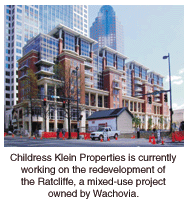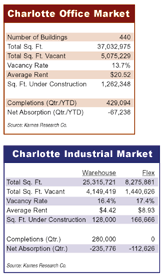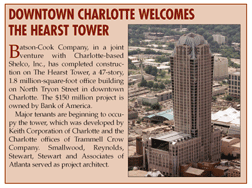CHARLOTTE POSITIONS ITSELF FOR ECONOMIC RECOVERY
Jack Bowman
 Charlotte,
North Carolina, is often referred to as the Capital of the New South.
Strategically located at the intersection of two major highways, interstates
77 and 85, Charlotte occupies the majority of Mecklenburg County. The
population of the city is roughly 600,000 and the Charlotte MSA ranks
26th in the United States with just over 1.5 million people. Charlotte,
North Carolina, is often referred to as the Capital of the New South.
Strategically located at the intersection of two major highways, interstates
77 and 85, Charlotte occupies the majority of Mecklenburg County. The
population of the city is roughly 600,000 and the Charlotte MSA ranks
26th in the United States with just over 1.5 million people.
There are eight Fortune 500 companies headquartered in Charlotte: Duke
Energy, Bank of America, Wachovia, Sonic Automotive, BF Goodrich, Nucor,
SPX and Family Dollar. The office market inventory of approximately 37
million square feet is generally described as having 11 submarkets with
the Downtown market comprising over 35 percent of the total space. The
next four largest submarkets, I-77 Southwest, Northeast, SouthPark and
Southeast make up another 43 percent. In the industrial/flex sector there
are eight submarkets totaling just under 34 million square feet with over
70 percent of the industrial/flex space located in the Southwest (airport)
and North markets.
There is no question that Charlotte's economy, and thus its real estate
market, has been and continues to be impacted by the influences of the
recession of the past 2 years. However, given the extraordinary growth
of the  1990s,
a period of relative dormancy should not be unexpected. Although the vacancy
rates have climbed over that past year, increased employment opportunities
and reduced new development should help to turn the situation around during
the second half of 2002. 1990s,
a period of relative dormancy should not be unexpected. Although the vacancy
rates have climbed over that past year, increased employment opportunities
and reduced new development should help to turn the situation around during
the second half of 2002.
Office
The city of Charlotte is probably best known today as one of the premier
financial centers in the world. In fact, Charlotte is home to the nation's
largest consumer bank, Bank of America, and Wachovia Corporation, which
became the fourth largest bank in the United States after the recent merger
with First Union. Combined, the balance sheets of these two institutions
contain almost $1 trillion in assets. In addition, the Charlotte branch
of the Federal Reserve Bank distributes almost $1 billion each day to
its member banks.
The scope of these financial institutions, together with the infrastructure
they support, have been and continue to be a key driver in the health
of the real estate industry in the Greater Charlotte area. During the
last half of the 1990s, the vitality of Charlotte's financial services
sector attracted more than 20,000 new jobs, only half of which were banking
positions. As an example, in 2001 TIAA-CREF occupied its new regional
office with over 800 employees in The University Research Park in Charlotte.
The company expects the office to grow dramatically -- it could house over
9,000 workers by the end of the decade. The University Research Park is
also home to First Union's (now Wachovia's) massive call center, totaling
2.1 million square feet with over 8,500 employees.
While there have been a number of new announcements made and several
exciting projects are being discussed, the fact is that office vacancy
has been increasing over the past year and now stands at just over 13.5
percent. Charlotte has not been immune to the effects of the tragedies
of September 11 and the general malaise of the national economy; however,
much of the vacancy is due to the availability of new product outpacing
the absorption.
 New
projects in downtown Charlotte include The Hearst Tower, Bank of America's
820,000-square-foot project developed by Keith Corporation and Trammell
Crow Company and constructed by Batson-Cook Company. The Hearst Tower
is currently fully leased. Another new downtown development is Gateway
Center, a 1.5 million-square-foot mixed-use project developed by Bank
of America and Cousins Properties. Johnson & Wales University, a world
famous hospitality institution, recently announced it would locate an
$82 million campus at the newly completed Gateway project. This new school
will be staged in over a period of several years and is being created
by the consolidation of existing campuses in Norfolk, Virginia, and Charleston,
South Carolina. Another prominent redevelopment is the Ratcliffe project
on South Tryon, owned by Wachovia and developed by Childress Klein. The
completion of the Ratcliffe, which includes office and retail components,
luxury condominiums and a mid-city park, offers a striking improvement
to that area of downtown Charlotte. New
projects in downtown Charlotte include The Hearst Tower, Bank of America's
820,000-square-foot project developed by Keith Corporation and Trammell
Crow Company and constructed by Batson-Cook Company. The Hearst Tower
is currently fully leased. Another new downtown development is Gateway
Center, a 1.5 million-square-foot mixed-use project developed by Bank
of America and Cousins Properties. Johnson & Wales University, a world
famous hospitality institution, recently announced it would locate an
$82 million campus at the newly completed Gateway project. This new school
will be staged in over a period of several years and is being created
by the consolidation of existing campuses in Norfolk, Virginia, and Charleston,
South Carolina. Another prominent redevelopment is the Ratcliffe project
on South Tryon, owned by Wachovia and developed by Childress Klein. The
completion of the Ratcliffe, which includes office and retail components,
luxury condominiums and a mid-city park, offers a striking improvement
to that area of downtown Charlotte.
Despite the recession's impact on the growth of Wachovia and Bank of
America, the vacancy rate in the downtown submarket is a very healthy
7.5 percent. There are a number of large blocks of space available in
several downtown buildings, including a 100,000-square-foot sublease by
Wachovia and the space vacated by Hearst Corporation after the move to
its new tower. However, activity seems to be increasing according to Maxwell
Hanks, a vice president/principal at Colliers Pinkard and leasing agent
for a large block of space in the BB&T Building. "Tenants are looking
for a central location, abundant and convenient parking and a cost effective
rent structure," says Hanks. "In a soft economy tenants gravitate toward
value."
Although three of the suburban submarkets have vacancy rates under 10
percent, higher rates around 18 percent and more are being recorded in
the Southwest, East, Northeast, North and CrownPoint markets. Probably
the most significant of these are the Southwest and Northeast markets.
Both markets have grown rapidly and are popular as corporate headquarter
locations but have suffered as demand diminished just as several new buildings
were delivered. With the increasing vacancy in the suburbs, landlords
are aggressively pursuing all transactions. Enticements such as free rent,
lease assumptions and generous tenant improvement allowances have returned.
As a result, many tenants are testing the waters as early as 18 months
prior to their existing lease expirations.
Within these submarkets, the most notable initiatives include major expansions
for TIAA-CREF and EDS in the University Research Park, the headquarters
relocations of SPX and Carlisle corporations into The Bissell Company's
Ballantyne Corporate Park in the Southeast submarket and the relocation
of Billy Graham's headquarters from Minneapolis to a new Childress Klein
development near the airport.
Another development that is getting attention in the Southeast submarket
is a master-planned, mixed-use project called Toringdon. Dene Ecuyer,
vice president of leasing for the developer, Lichtin Corporation, notes
that the "new urbanism concept of Toringdon has been well received in
the market as evidenced by the rapid leasing activity by high quality
tenants such as GMAC, Prudential and Selective Insurance."
Industrial
With the significant exception of the 280,000-square-foot Catawba Distribution
Center, there have been no recent additions to the warehousing and flex
inventory in the Charlotte submarkets. Nonetheless, this incremental warehouse
space was largely responsible for the increasing vacancy rate in the first
half of 2002. During this time vacancy in warehousing space stabilized
or declined in all submarkets except the dominant Southwest where the
addition of the Catawba Distribution Center and weakness in leasing existing
product produced a significant negative absorption. The overall vacancy
rate for warehouse space in Charlotte currently stands at just below 16.5
percent with flex space coming in at 17.4 percent.
Although delivery of new and proposed warehousing and flex space will
be substantially below prior years' figures, the anticipated subleasing
of over 430,000 square feet of warehouse space by U.S. Foods and John
Deere, together with the completion of 128,000 square feet of warehouse
space and 167,000 square feet of flex space, will be a definite challenge
to the leasing demand. Additionally, there is more than 2.3 million square
feet of warehouse space and almost 300,000 square feet of flex space still
in the proposal stage, which, if realized, could further dampen the recovery.
According to the Charlotte Chamber of Commerce, the investment that new
and expanding companies made in Charlotte during the first quarter of
2002 was the third-highest first quarter on record. For example, Ingersol
Rand recently committed to a 10-year term for nearly 350,000 square feet
of warehouse space owned by Highwoods Realty. According to Greg Copps
and Lawrence Shaw of Colliers Pinkard, who negotiated the deal, this lease
is significant not only because of its size but it is "indicative of an
increasing willingness by tenants to commit to large blocks of space."
Given that office and industrial investment is usually a first priority
in expanding or relocating, it should not take long for those expenditures
to reverse the trend of the past 2 years.
Land Sales
According to Bob Taylor of GVA Lat Purser & Associates, there is currently
a "ground" swell of commercial real estate activity in Charlotte. While
many sectors are down, the market for large tracts of land is up, says
Taylor. "The last 3 years have been the strongest I've seen," he continues.
"I attribute it to a combination of low interest rates, which have driven
the housing market, the availability of reasonably priced land and developers
that are planning and positioning their acquisitions to accommodate not
only residential but future office and retail as well. Investors are also
fueling some of the activity by moving some dollars from stocks to well
located, path-of-progress land parcels."
Transportation
A synopsis of Charlotte would not be complete without some mention of
three major transportation-related projects that will have a major effect
on the local real estate climate.
In late 1999, Charlotte's city leaders approved funding to improve and
expand the Charlotte-Douglas Airport. This $735 million project will enhance
and expand the number of gates for domestic, international and commuter
flights and will ensure that access and egress for passengers is both
safe and efficient.
Planning is now underway for the development of a light rail system to
share the right-of-way currently used by a trolley system tying the historic
SouthEnd to Downtown. The trolley/ light rail will ultimately travel from
Downtown, through the Convention Center and new Westin Hotel to the SouthEnd
and terminate in the bedroom community of Pineville some 20 miles to the
south. Economic development along this pathway has already commenced,
and it is expected to have significant impact on the value of adjacent
real estate.
Construction of an outer loop around Charlotte, Interstate 485, began
in 1989 and will continue toward substantial completion in 2008. That
part of the beltway, which is currently completed, has enabled the success
of the Southeast market, most notably Ballantyne Corporate Park, and is
expected to have a similar influence on undeveloped land in the northeast
and northwest areas of the market.
Charlotte's spirit of proactivity and cooperation between the public
and private sectors has never been stronger. The achievements of the 1990s
provided the foundation for even greater success in the years to come.
These projects demonstrate the optimism of the city's leadership for an
economic recovery in 2002 and 2003.
Jack Bowman is vice president, corporate services with Colliers Pinkard
in Charlotte, North Carolina.
©2002 France Publications, Inc. Duplication
or reproduction of this article not permitted without authorization
from France Publications, Inc. For information on reprints of
this article contact Barbara
Sherer at (630) 554-6054.
|
